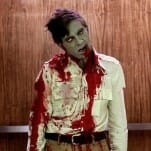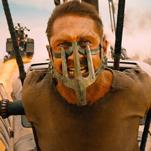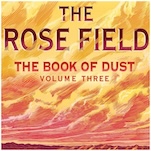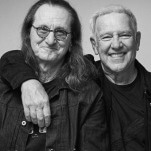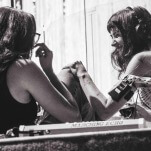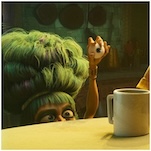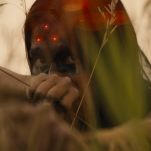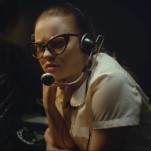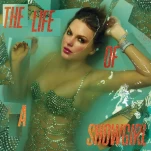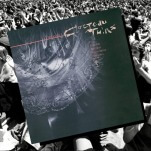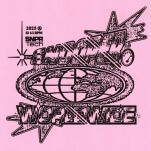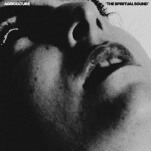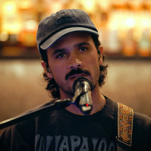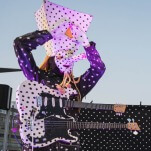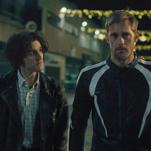Chris Sheridan Revs Up His Digital-to-Print Western Mashup, Motorcycle Samurai
Cartoonist Chris Sheridan’s Motorcycle Samurai is the glorious result of mashing together Western shoot-em-ups, jumpsuit-clad wandering swordswomen, Mad Max-ian desert survivalism and a sheriff rocking an Elvis pompadour and deep love of coffee. On shelves in bookstores this week, Motorcycle Samurai Volume One: A Fiery Demise is also the result of years of labor from Sheridan, a relative newcomer to published comics who helped publisher Top Shelf pioneer the digital-first guided-view format.
Hosted online at comiXology and Thrillbent, Motorcycle Samurai takes full advantage of the digital tricks available to Sheridan, including animated transitions and dialogue that fades in and out of panels. For Motorcycle Samurai’s first print collection, Sheridan combed through the book with a designer’s eye, choosing key frames, creating new art, and laying out a version of the story that stands alongside the digital-first iteration as its own distinct product.
![]()
Paste chatted with Sheridan over the phone to discuss the influences he proudly wears on his sleeve, the rigors of creating a book for the web and translating it to print and fan-casting his own characters.
Paste: You’ve explained before that Motorcycle Samurai got its start in an Elvis-themed convention sketchbook. At what point did it become clear to you that you had a complete story brewing around these stray ideas about Bruce Lee, Mad Max and old Westerns?
Chris Sheridan: Just in terms of visual elements, it was really appealing, and that drove me to continue. I felt like there was a depth of environment and character. Storytelling-wise, I’m a big person for action-as-character, and action or character as plot, and there was a lot to mine and a lot to explore. I definitely wasn’t going to get bored. [Laughs]
I remember reading Mignola talk about Hellboy and say he could have made him just a regular guy, but he would have gotten bored drawing him over and over. So that was a good impulse to think, if you end up getting to draw this character for a long time, make it someone interesting. Elvis and the ‘70s and Bruce Lee—they were so rich and so interesting, it helped me really explore a time frame I wasn’t familiar with, and to understand why they were so popular and pull out elements I was really interested in and continue to play with those.

Motorcycle Samurai Art by Chris Sheridan
Paste: How did you decide the Bruce Lee character was going to be a woman in your story?
Sheridan: I actually did go through an iteration where the White Bolt was a dude with spiky white hair. Partly, it was just to differentiate the characters, but narratively, it wasn’t that compelling to have it be a man. Once it switched to being a woman, it opened up a lot of areas to explore, and that just became another level of interest to the story and backstory. Part of what I was interested in was defining [Motorcycle Samurai] not as a traditional Western, and when I realized [making the White Bolt female] was an avenue I could go down, it just opened up that much more.
Paste: Your original pitch actually includes fantasy casting for all of the characters. How useful is that to you, as a creator, as you’re determining character voices and actions?
Sheridan: I think it helps differentiate voice and look and tone. I also thought it was a lot of fun to explore. Part of the pitch was a mash-up Western that had never been done: Clint Eastwood and John Wayne. They were the two biggest Western stars that never overlapped on screen, so just trying to figure out how that Traditional Western would play with the Antihero Western, and in exploring that, it meant going back and watching a lot of those movies. It helped me to find character actors who hadn’t been used in that way, like Toshiro Mifune. Imagine what he could do. I remember watching Grand Prix, where he was basically an administrative character, and the idea of him being a racecar driver was so much more interesting to me. It was sort of a jumping-off point to explore what those characters could be, and imagine those iconic actors in a different environment with no parameters.
Paste: Motorcycle Samurai wears its influences on its sleeve and doesn’t seem to take itself too seriously. There are blowout action scenes, but the heroes treat the confrontations like more of a hassle than a heroic destiny. Was it important for you to inject humor into the book?
Sheridan: Yeah, definitely. I think the tone was important to me, not to have it be too heavy. Those elements of fun are part of what I wanted to make sure were front and center. Again, I think Hellboy is a good framework for not being too heroic or taking itself too seriously. I didn’t want [Motorcycle Samurai] to get too over the top, and I think a blend of humor can help ground the absurdity. You can’t really look at those characters and take them too seriously, that’s a natural part of it. Plus, I feel if you look at any classic Western, there are always humor elements in those movies, whereas modern superhero books tend to get a little heavy. For me, this is supposed to be fun.
-

-

-

-

-

-

-

-

-

-

-

-

-

-

-

-

-

-

-

-

-

-

-

-

-

-

-

-

-

-

-

-

-

-

-

-

-

-

-

-










